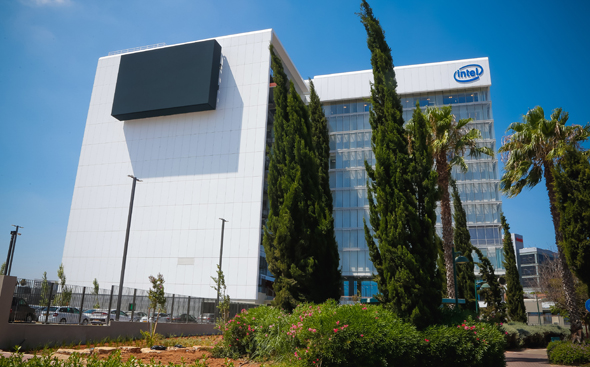
Intel-Israel’s sales leaped but workforce remains stagnant at 2019 figures
Last year the company’s sales jumped 21% but their workforce has remained similar to 2019 figures. “Success isn’t measured in workforce numbers,” says CEO Yaniv Garty
Meir Orbach | 12:48, 03.02.21
Every year Intel-Israel releases a report on
its yearly activity in the country, and while this year’s presents an impressive increase in output for the year 2020, it hides the fact that the workforce hasn’t grown alongside revenues. While Intel-Israel’s sales have leaped 21% from $6.6 billion in 2019 to $8 billion in 2020 - a high point for its 45 years of activity in Israel - its workforce numbers remained stagnant at 13,950 people.
In 2016, Intel-Israel had 10,200 employees.Every year that number increases mainly due to acquisitions of other companies. However, between 2019 and 2020 that number only grew by 200 people to 13,950 due to the acquisition of the Israeli startup Moovit for $1 billion. Moreover, it seems as if Intel has drastically cut back on its manpower in some of its departments. Two prior acquisitions, Habana Labs Ltd. and Mobileye, which are now at the forefront of global development, are recruiting manpower for the continual development of their products.
From the figures that Intel Corp. has published, it seems as if Mobileye is booming and during the last quarter of 2020 recorded a 39% leap in revenue to $333 million. In 2020, Mobileye’s activity grew by 10% and it brought Intel $967 million in revenues. Habana Labs, which was acquired for $2 billion, announced last year significant milestones and collaborations with AWS (Amazon Web Service), and over the past year those two companies are actively recruiting employees for positions.
At Intel-Israel’s two main activity centers, namely the R&D center and its production facility in Kiryat Gat in southern Israel, there has been a small decline in the workforce over the past year. According to the corporate responsibility report published at the end of 2019, Intel-Israel only employed 7,300 people in development positions, however in the latest report published on Wednesday, it showed that it only employed 7,000 people in such positions. The small decline in employees who work in the development sector stems from the sale of its Smart Home branch to the U.S. company MaxLinear.
That branch employed 300 people in Israel, and 700 worldwide. However, that figure still doesn’t provide a complete explanation of why other tech giants are recruiting workers in Israel and offering them attractive packages - among them Amazon, Facebook, and Apple - and yet that isn’t the case for Intel-Israel.
Intel’s facility in Kiryat Gat has received billions of shekels from the Israeli government. In 2018, when Intel Corp. extended NIS 40 billion ($12 million) for expanding its operations, it received NIS 3 billion ($907 million) from the Israeli government. Intel announced in its report that it spent 2020 by creating new technologies, such as its second-generation 10 nanometer microprocessor, coined Ice Lake. Despite that, there was a slight decline of workers in its Kiryat Gat facility, from 4,900 at the end of 2019 to 4,850 today.
“We didn’t fire people or furlough them”
In a discussion with Calcalist, Intel-Israel CEO Yaniv Garty explained that the workforce in 2020 is similar to that of 2019, with no decline in the number of workers. “Our facility has reached full production capacity with the optimal amount of manpower, and the only significant change was Intel’s sale of its Smart Home activities which had a branch in Israel. As for the bigger picture, we’ve retained the same manpower. Just like every year, that manpower sees a turnover. Over the past year, there was a particularly low turnover because of the pandemic. Looking at our performance, we don’t measure success in manpower figures, but rather in productivity.”
Garty explained that Intel has “28 different business branches in Israel, and we have a dynamic transition of employees between the different divisions. We haven’t fired people or furloughed them. Due to the different business divisions, we can simply transfer people to different units, and know how to address our needs with flexibility.”
Over the years Intel has grown, according to Garty, in two main spheres - organic growth and through acquisitions (23 of which were critical to growing Israeli manpower), but that doesn’t necessarily mean changing the manpower.
Alongside Intel Corp.’s positive reports during the fourth quarter showing $20 billion revenues, the Israeli rise is a source of satisfaction. “Having an $8 billion yearly output is a number that we’re very proud of,” Garty declared. “The high tech industry wasn’t hit by the pandemic, and part of it even took off, but our employees and entire teams who were forced to deal with the complications that the pandemic caused, are a source of great pride for us.”
Last year, many senior Intel executives, including incoming CEO Patrick Gelsinger, signaled their intentions to transfer part of their production to external companies. Garty promised that Intel’s facilities will stay in Israel for
many more years to come. “We are committed to the Israeli government and are upholding all the conditions of the grant in terms of output and also in manpower.”

